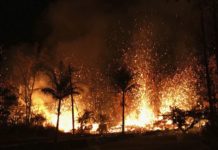Military crews were on standby with body bags for possible fatalities in the Keys while more than 5.5 million people remain without power across Florida.
Florida began the colossal task of cleaning up after Hurricane Irma on Monday as the remnants of the most powerful storm in Atlantic history limped north into Georgia and a demise over land.
Daylight exposed the extent of the damage in the hardest-hit areas of the Florida Keys and the south-west coast, whipped by the worst of Irma’s 130mph winds during the storm’s double landfall.
Officials in Monroe County warned of a potential “humanitarian crisis” in the Keys with military crews on standby with body bags for possible fatalities among those who failed to heed a mandatory evacuation order.
There were no reports of mass casualties, but Irma’s deadly toll continued to rise with five victims attributed to storm in Florida and 10 fatalities confirmed in Cuba. The hurricane claimed at least 25 lives in its 185mph rampage through the Caribbean last week, including the British Virgin Islands and British overseas territory of Anguilla, where relief efforts were continuing this week.
In the Florida Keys, one resident told the Miami Herald the storm “sounded like war”, while in Jacksonville rescue crews were sent into neighbourhoods flooded by Irma’s record storm surge.
Other severe flooding occurred in Everglades City, a small crab fishing town of about 2,000 people that was completely awash when the storm surge occurred on Sunday. On Monday, water marks up to about 5ft were visible on the walls of houses. City Hall, remarkably grand for a tiny community, was an island, encircled by a lapping pool.
In Marco Island on the west coast, where Irma made its second Florida landfall on Sunday, and in Naples to the north, authorities were assessing the impact of Irma’s storm surge.
The hurricane’s reach stretched across Florida. More than 7 million people were without power, 2 million of them in communities around the cities of Miami, Fort Lauderdale and West Palm Beach. Reports of property damage and beach erosion were widespread and pictures emerge of yachts smashed to pieces in wrecked marinas.
More than 6 million people, evacuated from their homes as Irma bore down on the state on Saturday as a deadly category 5 monster, anxiously awaited news about when they could return.
Donald Trump, speaking at a 9/11 memorial at the Pentagon on Monday, said the government stood behind the victims of Irma and other recent disasters including Hurricane Harvey, which struck Texas last month.
“These are storms of catastrophic severity and we are marshalling the full resources of the federal government to help our fellow Americans in Florida, Alabama, Georgia, Texas, Louisiana and Tennessee and all of those wonderful places and states in harm’s way,” he said.
We’re drawing every resource we can, locally, the state, the federal government. We have so much damage now
“When Americans are in need, Americans pull together. And we are one country. And when we face hardship we emerge closer, stronger and more determined together.”
Teams from the federal emergency management agency began work in Florida to assist the relief and recovery effort, which some experts estimate could reach $290bn, combined with the cost of Hurricane Harvey’s strike.
Rick Scott, the Florida governor, was taking an aerial tour of the Keys and south-west Florida. “We’re really concerned to save every life there,” he said before the flight.
“We’re drawing every resource we can, locally, the state, the federal government. We have so much damage now around the state. Power lines are down, we have roads that are impassable. Everybody’s got to be patient as we work through this.”
All 7,000 members of Florida’s national guard were on duty, Scott said.
Video from the Keys, the low-lying island chain to the south of the state, revealed destroyed mobile homes and fields of debris strewn across US 1, the only highway that links the archipelago to the mainland. The road was submerged by a storm surge of up to 15ft. On Monday sheriff’s deputies were blocking off access points to the Keys to returning residents, as rescue teams moved in.
Martin Senterfitt, emergency management director for Monroe County, said the US air force and air national guard had planes on standby to tackle what he called “a looming humanitarian disaster”.
Residents who remained in the Keys as Irma made first landfall at Cudjoe Key, about 20 miles from Key West, said the devastation was massive.
“About 5 o’clock in the morning when it really started to blow, the trees started snapping and we saw roofs getting ripped off,” Yeorgo Kapriris, who lives on Summerland Key, told the Miami Herald. “The water came up about 5ft, we lost our van, we lost everything.”
On Miami Beach and in downtown Miami, which suffered significant flooding in the business district of Brickell Avenue, maintenance crews were cleaning debris from the roads as the waters receded.
The entire south-east region remained under a city-by-city curfew to allow recovery crews to work and to free up law enforcement resources. In Broward and Miami-Dade counties, authorities reported more than two dozen arrests for looting.
Fears that south-east Florida and its 6 million residents would receive a first full-on strike from a major storm since Hurricane Wilma wrecked the area in 2005 eased when Irma took a late veer to the west on Saturday after moving north from the Cuban coastline.
Signing a federal major disaster declaration for Florida on Saturday, Trump acknowledged: “We may have been a bit lucky that it went on the west. It may not have been quite as destructive.”
In Broward County, gusts of almost 100mph were recorded, accorded to the Miami-based National Hurricane Center (NHC), before reporting equipment was blown away.
Barbara Sharief, the county mayor, told residents: “When we were in line for a direct hit from this monster storm we were bracing ourselves for the worst. Now I urge you to let the county’s recovery team do its jobs to ensure our community is safe before you resume your normal activities.”
The NHC downgraded Irma to a tropical storm early on Monday but warned it could still cause damage and flooding as it moved north towards its ultimate dissipation inland within 72 hours.
“Irma continues to produce very heavy rain and inland flooding across much of the northern peninsula and eastern panhandle of Florida and southern Georgia, which is quickly spreading to the rest of the southeast United States,” NHC senior hurricane specialist Richard Pasch said.
Source: theguardian.com










